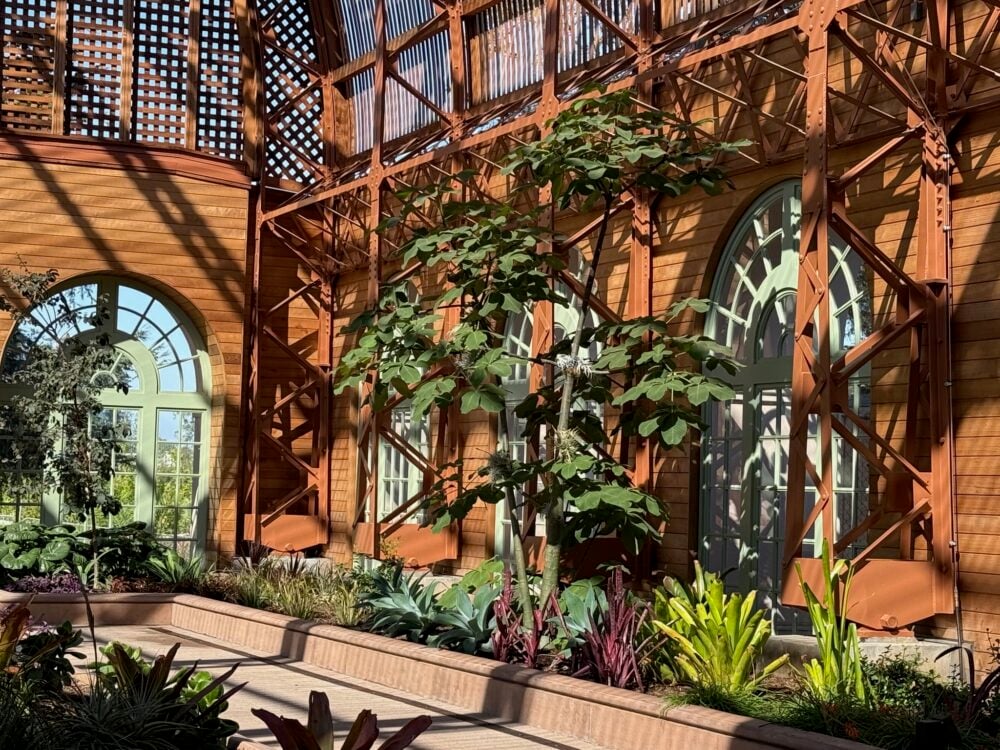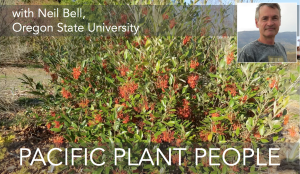
A Soul’s Expansion Through Gardening

Contributor
- Topics: Inspired Gardens and Design
Fall 2024
In the concrete jungle of New York City, I found an unexpected refuge amongst the towering skyscrapers and sprawling sidewalks: organic gardening. Despite the oppressive summer humidity and bitter winters, growing my own food and herbs nourished my soul, while cultivating green spaces allowed it to fully express itself. What started as a simple way to bring life into a small space soon became something much deeper. It offered an element of grounding in a city that often felt overwhelming. Little did I know, this would be the beginning of a journey that would take me far beyond the concrete of Brooklyn.
Despite my soul’s expansion through gardening, starting a garden in Brooklyn came with its own set of challenges. My 500-square-foot apartment, though advertised as a one-bedroom, was really just a cleverly disguised studio. High ceilings made up for the lack of square footage, and the exposed brick walls on the north end of the studio added character. However, the charm came with a quirk, as most NYC apartments do—my Sunday mornings were often accompanied by the soulful hymns and fiery sermons from the neighboring church that shared the brick wall. Although space was both physically and metaphorically limited, working within those constraints taught me that growth can happen anywhere, even in confined spaces.


With only one north-facing window offering limited light, I knew I needed more space and sun to nurture my plants. Persistent negotiations with my skeptical landlord granted me access to the neglected, shared patio behind the apartment building where I could create an impromptu garden.
I repurposed crates, concrete blocks, and containers scavenged from the neighborhood dumps and community gardens to create space-saving raised beds. In addition, I connected with the Brooklyn Botanic Garden, where I was able to access seed and plug donations, cuttings, compost, and even free classes. These resources, along with a wealth of shared knowledge, became invaluable in the early stages of my gardening journey. In many ways, transforming this neglected patio into a vibrant green space felt like I was rebuilding a part of myself, too.
Initially, my gardening efforts were marked with trial and error. I planted sun-loving herbs in the shadiest part of the patio, only to see these pioneer plants wither. It was a reminder that growth is often encouraged or deterred by a nurturing or unstable environment. I slowly began to adapt, focusing on shade-tolerant varieties like butterhead lettuce (Lactuca sativa var. capitata) and flat-leafed parsley (Petroselinum crispum var. neapolitanum)—learning to work with the flow as opposed to fighting against it. I began to realize that resilience is often about adapting to perceived limitations and using your inherent resources to flourish.
Repurposing containers not originally intended for plants taught me the importance of adding amendments. Improving the soil became a metaphor for tackling self-improvement at the ground level. Just as plants need space to thrive, I realized I needed more space in my own life to breathe and grow.
In tandem with the seasonal shifts came a shift in my own energy and mood. I found myself struggling with depression partly due to the lack of sunlight filtering through my north-facing window. In search of both physical and emotional light, I turned to herbalism and plant medicine, which offered a deeper connection to nature. My guerilla gardening in Brooklyn was indicative of the direction I would focus my energy.


Listening to a Lingering Melody
Regardless of the growth I experienced in my confined Brooklyn space, the sun-drenched hillsides of Southern California, where I once lived, lingered in my mind like a catchy melody. I longed for more light, more room to grow, and a hands-on experience with medicinal California native plants— particularly yarrow (Achillea millefolium), California poppy (Eschscholzia californica), and yerba buena (Clinopodium douglasii). They called to me, planting the seeds of a future journey westward.
After navigating the uncertainty of COVID-19, I finally made it to California in early 2021. My new home in the Watts neighborhood of South Los Angeles came with a patchy 980-square-foot yard, which served as a blank canvas that mirrored the fertile new start I was seeking. I wanted this garden to be more than just a personal project—I wanted it to become an urban space of renewal, one that I hoped would inspire others to embrace native and drought-tolerant plants, water-saving techniques, and the joy of growing their own food. The garden and I were simultaneously starting anew, with the promise of growth ahead.

When faced with a creative challenge, my instinct has always been to start with free resources and rely on my own strengths. The transformation of my new garden in Watts was no different. Learning to work with limited space and light in Brooklyn, here I was tasked with transforming my patchy yard into a thriving native landscape. But this time, it wasn’t just about the plants—it was about creating a place where the garden, the surrounding community, and I could flourish together.
The challenges in Watts were much different from those I faced back on the East Coast. The neighborhood’s reputation is interwoven with Los Angeles history, lending its name to pivotal moments of civil unrest such as the 1965 Watts riots and the 1992 Watts truce which reduced gang violence in the area. Communication with my neighbors was sparse as many of them were Spanish-speaking, and my broken Spanglish often couldn’t suffice. Fortunately, I lived just two minutes away from the Heart of Watts Community Garden and five minutes from MudTown Farms, a local farm dedicated to combating food insecurity and providing access to nature for local residents.
However, I soon learned that the Heart of Watts garden was in a power struggle over ownership of the land and had been indefinitely closed. MudTown Farms was only recently established and had little work available at the time. This meant my home garden would have to become my solitary greening space. In the same way I learned to adapt in Brooklyn, I was determined to create a space that could serve as a source of healing and connection, while keeping climate change top of mind. To address these roadblocks, I aimed to challenge the status quo of sustainable practices in an underserved area, growing my own food as a healthy way to support myself and my community, while showcasing the wide spectrum of California’s native flora. Naturally, I began by seeking resources to help with this transformation and found exactly what I needed.
The Los Angeles Department of Water and Power (LADWP) offers a rebate of up to $3 per square foot for replacing existing lawns with native, drought-tolerant plants and water-saving features. This opportunity to upgrade my landscape—and provide beauty, medicinal plants, shelter, and food for local wildlife—was too good to pass up. Reducing my water use and increasing property value were the cherries on top, and the city footing the bill was the chef’s kiss.
Determined to make the most of this new chapter, I enrolled in free online classes from organizations like Green Gardens Group and Turf Transformation to deepen my understanding of native plants, water-saving techniques, and sustainable landscape design. I meticulously researched the growth habits and ecological benefits of each plant, crafting a list and design palette that would thrive in my yard.
I applied for the LADWP rebate program, using my self-taught Photoshop skills to create a detailed plan showcasing both my vision for a sustainable, beautiful landscape and the lessons I had learned from my guerrilla gardening days in Brooklyn. The odorous, shade-loving Catalina currant (Ribes viburnifolium) found its home in the northern part of the yard with speckles of sunlight to mimic its natural growth under our native oaks (Quercus spp.). Working with nature and its perfect order, instead of trying to fight against it, showed me that we can thrive where we are planted if we work with our situations rather than waiting for the opportune time.

I added a native wildflower patch featuring baby blue eyes (Nemophila menziesii), arroyo lupines (Lupinus succulentus), and purple Chinese houses (Collinsia heterophylla), each chosen for their ability to thrive in Southern California’s climate. I also aimed to incorporate my knowledge about container gardening. Knowing that dudleyas thrive in containers and add aesthetic value, I incorporated plans for a potted giant chalk dudleya (Dudleya brittonii) to serve as a stunning centerpiece at the entrance of the house. A couple of weeks later, the LADWP emailed my approval to move forward with the project, marking the beginning of a significant new chapter in my gardening journey.
Transforming the yard was both exhausting and exhilarating. In two days, with the help of a few friends, we removed the grass using a sod cutter and replaced 980 square feet with compost and mulch. Over the following weeks, I sourced the plant material from local nurseries and placed them according to the plan.


Just as it takes one to two years for a California native plant to fully establish itself, I found myself gradually settling into the Watts community. I joined the local neighborhood council and ran for office as my district’s representative, with a campaign centered on establishing more tree canopies, rehabilitating the local Heart of Watts community garden, and creating job opportunities through gardening and horticulture. Losing by only one vote, I learned that creating an impact doesn’t have to be through obtaining a public platform.
I continued to do what I could with what I had and built strength by working with the community. As the garden matured and the plants deepened their roots, so did I. The flourishing garden didn’t just attract pollinators—it drew in neighbors as well, who would stop by to admire the progress, often leaving with a small cutting or a generous chunk of advice.
After months of watching the garden grow, I began to feel that I was making a meaningful impact by creating accessible green spaces and inspiring the community. I soon noticed one neighbor uprooted their St. Augustine grass from their parkway strip, and laid down a layer of mulch and compost. Another created a small native wildflower patch, while many asked for my mulch, compost, and lowboy trailer contacts.
The realities of urban gardening were soon to reveal themselves. Even in the most beautiful spaces, adversity is never far behind. Gophers (Thomomys sp.) were the first wave of pests to cause destruction to the garden, a problem I never knew existed back on the East Coast. Frequent theft led to rakes, hand trowels, and even brooms going missing. Vandalism was commonplace, as was destruction from stray dogs and cats. One day, the driver of an 18-wheeler wedged himself on the parkway strip, destroying all the native plants as a result. Each obstacle demanded a creative solution, just like a flower transitioning from bloom to fruit.

During this period, my career took a significant step forward when I became the head gardener and assistant curator at the Huntington Library and Botanic Gardens, working in the renowned Rose Garden. This role provided not only professional growth but also a deep sense of purpose. Working with roses (Rosa)—plants with a deep community of fanatics that celebrate both their beauty and resilience—felt symbolic of my own journey. The garden became more than just a job; it was a space where I could continue creating beautiful landscapes while channeling my horticultural expertise to real-world challenges. This position also gave me a platform to inspire others, showing how perseverance and self-reliance can bloom even in the most arid circumstances.
Despite the purpose I found in my work, my home life presented a stark contrast. While I was cultivating healing through gardening in my professional life, my personal life was unraveling. I was going through a divorce which left me feeling uprooted and isolated. With our 8-month-old daughter beginning to pick up our verbal and emotional cues, I made the difficult decision to move out of the family home to maintain the peace. It was a painful reminder that while I could control the growth of plants, life’s challenges often came without warning.
My garden back at home was no longer my own. This was a place where the salvias (Salvia) nourished the hummingbirds, and caterpillars found refuge under the lettuce greens. This place had enlivened our little corner of Watts with splashes of color from the native wildflowers and the bees and butterflies that accompany them, and made the community proud. Though I found comfort in my work at the Huntington, I couldn’t escape the reality that the garden I had poured so much of myself into at home was gone, save for two empty raised beds and a rose bush with an assortment of weeds hugging its roots.


That loss was a painful echo of everything I was going through—losing my home, my sense of reality, and my money through exorbitant lawyer fees and legal costs. But as with nature, where one season’s end signals the beginning of another, this loss made space for new opportunities to bloom.
While I had lost that one garden, countless others were waiting for me. Through a Master Gardener service opportunity, I began to work with the Santa Monica Police Activities League (PAL) to build an outdoor garden and curriculum for the kids attending the after-school program. This gave me the chance to introduce the next generation to the joys of gardening, showing them how growing their own food can be a source of wonderment and empowerment.
I also began working at an anti-recidivism program with people who were formerly incarcerated, teaching them how to cultivate plants while rebuilding their own lives through mindfulness—an experience that reinforced the transformative power of gardening and reassured me that I was walking in my purpose.


My landscape design inclinations blossomed into a second job, as clients began piling in after my contact information was listed on a website where I obtained an irrigation certification. I was able to express both my love for design and aesthetics with horticultural knowledge, which was deeply fulfilling. I began offering workshops and lectures about native plants and sustainable gardening practices, helping others create accessible green spaces in their communities.
My life was at a point where all my activities centered around creating gardens and making a difference, which was my intent when I first volunteered for this journey. What started as a personal loss evolved into a larger calling, allowing me to use my gardening passion and expertise to impact countless lives. Each new garden I helped create became a testament to the resilience I had learned to embrace, both in my personal journey and in the natural world.
Gardening taught me that, like life, a garden is ever-changing. With each season comes new challenges and new growth, but with that growth comes the opportunity for fresh blooms. As I continue to nurture my own inner garden, I’m reminded and inspired by the resilience and adaptability of native California plants like the fragrant California sagebrush (Artemisia californica), a shrubby plant often known for encouraging dreamlike states and enhancing intuition.
After a wildfire, it responds by resprouting from its roots and germinating seeds in the nutrient-rich ash. It was designed to go through the heat in order to recreate itself, much like a phoenix arising from its ashes after exploding in a ball of flames. We, too, are created to withstand the embers of transition, and must sometimes go through the blaze to reestablish our roots, reorient our senses, and emerge from the dirt stronger and more resilient than before.











Responses